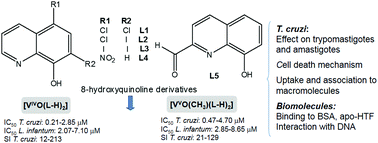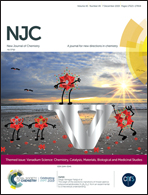Exploring oxidovanadium(iv) homoleptic complexes with 8-hydroxyquinoline derivatives as prospective antitrypanosomal agents†
Abstract
Ten structurally related homoleptic complexes, including three new compounds, were synthesized: five [VIVO(L-H)2] and five [VVO(OCH3)(L-H)2] compounds, where L–H = L1-H–L5-H are monodeprotonated L1–L5 8-hydroxyquinoline derivatives. The compounds were characterized in the solid state and in solution. All complexes show inhibitory activity against Trypanosoma cruzi and Leishmania infantum, most within the 0.2–5 μM range, T. cruzi being more sensitive to the compounds than L. infantum. The compounds show high selectivities towards the parasite, evaluated using VERO cells as a mammalian cell model, as well as higher activity against T. cruzi than the reference antitrypanosomal drug nifurtimox. The antitrypanosomal activity depends on the nature of the substituents on the 8-hydroxyquinoline moiety, [VIVO(L1-H)2] (L1 = 5,7-dichloroquinolin-8-ol), with IC50 = 0.21 μM, being the most active and selective compound of the series against T. cruzi, and one of the most active against L. infantum (IC50 = 2.5 μM). A trypanocide effect of [VIVO(L1-H)2] was observed when incubating parasites with 10× the IC50 value and a late apoptotic/necrotic cell death mechanism is suggested. A preferred association with the soluble protein fraction of cells is also observed (49.4% of total vanadium association). [VIVO(L1-H)2] is shown to affect not only the infection potentiality of cell-derived trypomastigotes but also the proliferation of intracellular amastigotes, the two parasite stages more relevant in the mammalian host after infection. By measuring circular dichroism spectra of solutions containing either human serum apo-transferrin (apo-HTF) or bovine serum albumin (BSA) upon adding the compounds, it is shown that both the free ligands and the VIV- and VV-complexes bind to these proteins. From data determined from fluorescence quenching measurements with BSA, the determined Stern–Volmer constants are typically slightly higher for the ligand precursors than for the corresponding [VIVO(L1-H)2] compounds, the calculated conditional binding constants at pH = 7.4 being ca. 105–106. The fluorescence competition measurements with DNA bound to ethidium bromide typically yield relatively small decreases in fluorescence, VIV- and VV-complexes with L1 showing higher quenching.

- This article is part of the themed collection: Vanadium Science: Chemistry, Catalysis, Materials, Biological and Medicinal Studies


 Please wait while we load your content...
Please wait while we load your content...